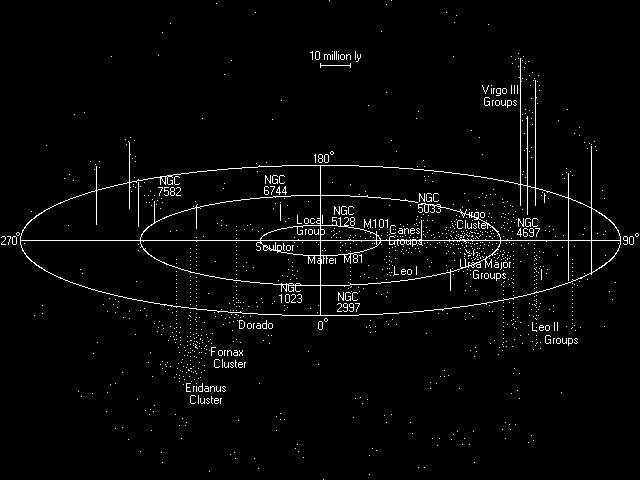
The Virgo Supercluster of galaxy clusters

The Virgo Supercluster of galaxy clusters
This map covers the outside range of my mighty 8" specular.
'For I will consider thy heavens, even the works of thy fingers: the moon and the stars, which thou hast ordained.'
Psalms VIII.3
* * *
'The Heavens declare the glory of God; and the firmament sheweth his handywork.'
Psalms XIX.1
* * *
'The Particle Theory of Light? I just don't see it.'
William Diffin
A selection of my observations of objects far beyond the reaches of the Solar system: multiple star systems, remote star clusters, and nebulæ; and then external galaxies far beyond the confines of the Milky Way Galaxy that no one alive today will live to visit. Probably.
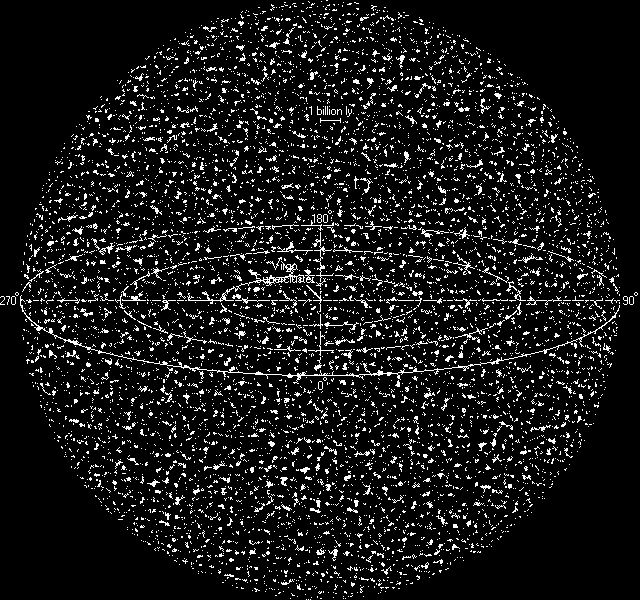
A map of the observable Universe
NB some of the observations that follow are of objects at extremely remote distances, in the millions of light years, or the millions upon millions upon millions of miles. As such I use the so-named 'British' numbering convention for large numbers, where a Latin prefix (bi-, tri-, quad-, etc.) denotes powers of a million i.e. 1 billion = 1,000,0002 = 1,000,000,000,000; 1 trillion = 1,000,0003 = 1,000,000,000,000,000,000; 1 quadrillion = 1,000,0004 = 1,000,000,000,000,000,000,000,000; etc. I use this in preference to the more widely-used 'American' numbering convention i.e. 1 billion = 1,000,000,000; 1 trillion = 1,000,000,000,000; 1 quadrillion = 1,000,000,000,000,000; etc. as it makes more linguistic and mathematical sense, is easier to comprehend, and makes it simpler to describe larger and larger numbers. Incidentally, in point of historical fact, both the 'British' and the 'American' conventions for naming large numbers originated in France. The largest number I have troubled myself to give a name to is deciesmiliaoctingentiquadrilillion, that is to say ten thousand eight hundred quadrillion powers of a million or 1,000,00010,800,000,000,000,000,000,000,000,000, which is only just too large to fit in the known Universe if written out in full by hand in Arabic numerals in one long line.
Observation #200, 2011.II.8 - Sombrero Galaxy, Messier #104
As a preliminary to my first survey of the Virgo Galaxy Cluster, took the opportunity to catch the Sombrero Galaxy below it, as this is possibly the only time of year when it is high enough to usefully observe from my location. The galaxy lies within a streamer of galaxies extending south of the Virgo Cluster, and is about 30 million light-years from Earth. It is unusual in that it has a large central bulge and an enormous dark equatorial dust lane.
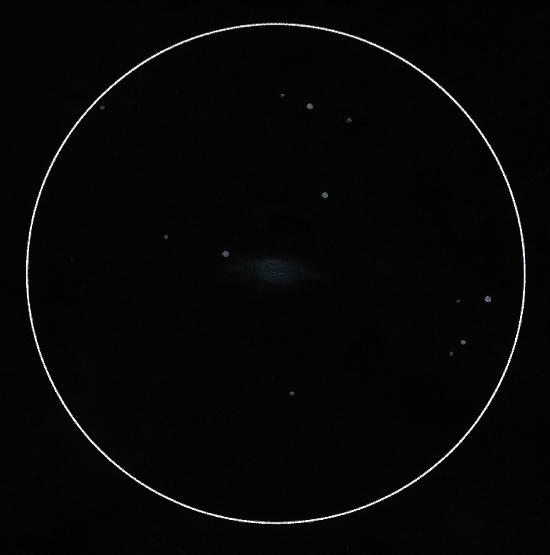
SOMBRERO GALAXY, MESSIER #104
2011.II.08.0339 UT
The image is a photographic negative of a drawing which I made, in photographic negative.
* * *
Observation #111, 2009.V.19 - Mizar multiple star system
2215
With Saturn out of range, looked around the sky for a target
and noticed Ursa Major directly overhead, and immediately thought of a book I
have been reading lately: In the High Heavens by Sir Robert S. Ball,
written towards the end of the nineteenth century. The chapter: 'The New
Astronomy' is about spectroscopy, that is to say using a spectroscope to analyse
the light from a star in order to discover the star's composition, and also to
distinguish any companion stars too close to the primary to be separated by any
telescope. In this connection the star Mizar is mentioned. Mizar is the second
star along the 'tail' of the Great Bear, and is accompanied by a companion which
is visible to the naked eye, named Alcor. Alcor has been known since ancient
times and the ability to observe it was used as a test of eyesight, and although
this star is readily visible today it is perfectly possible that it was fainter or closer to Mizar in previous ages. Mizar itself is a telescopic double, with a still closer
companion, ζ Ursæ Majoris. All this has been well-known for centuries. However with the
nineteenth-century invention of the spectroscope, it was discovered that Mizar
itself has a spectroscopic companion. This is detailed in Sir Robert S. Ball's
book; the spectral lines of Mizar were seen to double, open out, and close
again, and it was inferred that this was due to interference from the spectrum
of a closely orbiting companion star. It had been calculated from the amount by
which the lines open and close that the stars were moving around each other at
fifty miles per second, and from the rate at which the lines open and close that
the stars orbit one another at a distance of 150 million miles. Finally, the
Victorian astronomers were able to calculate from this information that the
Mizar spectroscopic double has a mass forty times that of the Sun. This
understanding of the Mizar System was wholly new at the end of the nineteenth
century, and it could not have been long before the spectroscopic companions of
both ζ Ursæ Majoris and Alcor were also discovered, making Mizar a senary system.
[This raises a point which deserves a brief essay on the conventions for naming numbers. 'Senary' means having six parts, after singulary, binary, ternary, quaternary, quinary; respectively meaning composed of one, two, three etc. parts. Compare with primary, secondary, tertiary, quartary, quintary, sextary, meaning first, second, third, etc. in rank or degree. But after 'senary' and beyond 'septenary' meaning of seven parts, there are as yet no words in the English language to denote 'of eight parts' or 'of nine parts', etc. The only exception is the word 'nonary', which could fit the pattern, and which is used somewhat illogically in mathematics to denote a group of nine, or the base-nine number system, with the number nine as radix (base-ten is known as 'decimal', base-eight is known as 'octal', apparently after a prefix of the Latin cardinal numbers decimus meaning tenth, and octavus meaning eighth, and a suffix of '-al', so one might have expected base-nine to be 'nonimal' after Latin nonus meaning 'ninth', and then again base-two is known as 'binary' and not 'secundal', base-six as 'senary' and not 'sextal', and base-sixteen as 'hexadecimal' and not 'sextusdecimal'). Such words are necessary to define large multiple star systems, and bring them within the grasp of wider human comprehension through language. Again, the terms primary, secondary, tertiary, etc. are similarly relevant in order to denote individual members of star systems in terms of their rank i.e. which stars are orbiting which other stars, and in what order of distance. Again, in English at least, after sextary, which is as yet only used to denote any of the six divisions of the City of Venice, there are no words to define the seventh, eighth, or higher (lower) ranks in a system. Therefore let us define the conventions as they appear from such words as already exist. Let words denoting 'consisting of n parts' be constructed by a prefix of the Latin distributive number n, followed by the suffix '-ary'. Hence 'of seven parts, 'of eight parts', 'of nine parts', 'of ten parts', 'of eleven parts', 'of twenty parts' etc. may be defined respectively by the words: 'septenary', 'octonary', 'novenary', 'denary', 'undenary', 'vicenary' etc. from Latin septeni, octoni, noveni, deni, undeni, viceni, etc. respectively meaning each of eight, nine, ten, eleven, twenty parts etc. Again, let words denoting 'of nth rank' be constructed by a prefix of the Latin ordinal number n, followed by the suffix '-ary'. Hence 'of seventh rank', 'of eighth rank', 'of ninth rank', 'of tenth rank', 'of eleventh rank', of 'twentieth rank' etc. may be defined respectively by the words: 'septiary', 'octavary', 'nonary', 'deciary', 'undeciary', 'vicensiary' after Latin septimus, octavus, nonus, decimus, undecimus, vicensimus etc. respectively meaning eighth, ninth, tenth, eleventh, twentieth, etc. Note that in this convention, 'of nine parts' is defined by 'novenary', from Latin distributive number noveni meaning each of nine parts, and not by 'nonary', which is used to mean 'of ninth rank', from Latin ordinal number nonus meaning ninth. This is the convention which I have used to describe the six stars of the Mizar System. ]
Looking at Mizar with just the eyeglasses I wear for short-sightedness, Alcor was plainly visible. Turning the telescope on Mizar, at 40× magnification the three principle components, Alcor, Mizar, and ζ were in evidence, with ζ very close to Mizar, practically touching. It was fascinating to note the change in appearance of these stars whilst adjusting the focus, and difficult to verbalize the impression which the view gave. This merits another brief essay.
When one first considers the stars in general at all, any stars, with a child's eye, one visualizes them all as being practically identical to one another, as being identical points or tiny five-pointed shapes of light; very high overhead, but not so high that they could not be plucked down whilst sitting on a friendly adult's shoulders perhaps. Later one learns that the stars represent other suns, perhaps more or less like our own Sun, the star that is always taken for granted. When one learns that stars can be wildly different in size and composition and temperature and colour, one imagines them differently, more scientifically, in terms of their vital statistics, and with that one might assume that one has fathomed the stars and understands their nature as it really exists. But when one actually observes individual stars in closer detail, one finds that the apparition of each individual star has an individual character all of its own, which, although it may require some subtlety on the part of the observer to perceive it, is nonetheless entirely unique and unlike the character of any other star in the sky. When it comes to observing the heavens, certainly the human eye is capable of seeing more than the human brain is capable of immediately comprehending, and possibly the mind interprets this extra information in terms of an impression of character and of an emotional reaction to that character, the sense of an external intelligence. Such impressions are human manifestations of any conscious entity's inherent tendency to attempt to comprehend and come to terms with the predicament of its being. In this case, in human terms and in terms of the science of astronomy, the impressions represent an attempt on the part of an Earthbound human observer, with concerns of an on the whole sweet and Earthly nature, to come to terms with the awesome and awful spectacle of the gigantic and overwhelmingly hostile wilderness that exists beyond the Earth, of other enormous star systems and the vast abysses of void which separate them, of the realization of the slender thread upon which Earthly life's existence depends, and of the apparent hopelessness of the human race's position, its utter alienation from the natural scheme of the Universe, by means of a cool steady stare and a sympathetic reasoning mind. Such things are never written about in astronomy books, although doubtless the impressions represent data which may be measured and interpreted scientifically, if not now then at some future stage. But in any case, with the sense of the stars' apparently impossible remoteness banished by the telescope, the idea that all stars are of a similar if not identical character to our own Sun is entirely banished also.
It is difficult to describe the emotive impressions that the Mizar system evokes in particular, except poetically in prose, or by comparing them to music, or in terms of music, which seems slightly ridiculous in what is after all a piece of casual empirical research. But in point of fact it would be far more ridiculous to describe the Sun for example as being merely a very bright yellow ball of light, or even as a stupendous mass of hydrogen and helium gas undergoing thermonuclear fusion at its core under the pressure of its own gravity, than to describe him as, say, 'the kind old Sun', that bright and joyful star which gives life to all of us and upon whom it is endlessly delightful to contemplate, or even as a child might draw him, with a beaming smile and rays of light emerging from him in all directions. The Sun Has Got His Hat On. This seems to me an especially apt if unscientific description, given the seemingly endless gift of light and life which the Sun lavishes upon our good Earth. As for the distant stars, since they are so remote and as yet unknowable, it is difficult to describe other star systems except intuitively, in terms of the impressions and primal emotive responses which they elicit by virtue of their distinctive characters, as perceived from distances so enormous that it seems foolish to seriously contemplate - never mind attempt - traversing them. Intuitive description without the authority of definitive knowledge is nigh impossible to bring off without appearing ridiculous, or hypocritically or even offensively holier-than-thou. Such descriptions by necessity are vague and intuitive, and hint at truths which may be wildly inaccurate. But it is important to try to describe remote unknowable star systems, since dealing intuitively with the unknown is the first step to knowledge, and knowledge is what ensures the survival of life on Earth, which needs no other justification but itself. By describing the character of a distant star system such as Mizar intuitively, without direct knowledge, a process is initiated which must inevitably lead to understanding the character of the system intimately and at first hand, much as the Ancients' attempts to understand the Sun and planets by describing them as gods initiated a process of empirical scientific inquiry, which has thus far culminated in the manned reconnaissance of the Moon and the remote exploration of the other planets. My point is that I believe that it is at least as if not more relevant to us as human beings, to describe stars in terms of the impressions they create in the minds of observers, and of how their appearance resonates with the human imagination thus provoking a human emotional response, than to describe them in purely scientific terms which can have no direct bearing on human beings who are not scientists, and which by seeming irrelevant to the vast majority of human beings only serve to make the stars seem irrelevant to human beings in general, thus alienating us all further from the stars in an apparently moribund world. The human physiology, sense perceptions, private imaginings and emotional responses which make scientific descriptions possible have all evolved under the overwhelming influence of one star i.e. the Sun. If life is to survive, human beings must inevitably escape the influence of the Sun and travel to other stars; this is so much an obvious fact that we may as well say that it is God's Will; to suggest that human beings are not worthy or evolved enough for such an undertaking, and that some more advanced species will take up the challenge following on after human extinction is contemptible; we are capable of conceiving of and working towards such a goal now, and indeed have been for two million years, at least those of us who are wide awake, lucid, and have respect for the overwhelming power and purpose of the human imagination. If we are to escape the influence of our parent star then, it would be helpful to understand just how much of who we are and what we perceive as human beings is coloured by our star's overwhelming and on the whole beneficent influence, before we can understand what sort of influence other stars may have on human beings, indeed on human souls born under the light of another star. In this connection I believe that it must also be helpful to describe other star systems intuitively, in terms of the impressions and primal emotive responses which they elicit by virtue of their distinctive characters, in a similar fashion to that in which I have just described our own Sun, beaming away at us benignly. In so doing, one does feel a sense that the impressions one forms of other stars were deliberately sent from those stars. Although that may or may not be the case, that the shining substance of other stars possesses some form of conscious intent that we, as beings whose own substance is only a by-product of our own star's formation, may perceive, I must emphasize that in actual fact those impressions are a unique by-product of my own imagination, or of the human imagination insofar as other people agree with them.
The Mizar Senary Star System is no different to the Sun in that it no less stands up to being described in terms of an impression of character, and yet it is nothing like our Sun. In appearance, Mizar, and Alcor in the same system, appear respectively as a bright white star with a dim grey star close by. Through a telescope, the bright white star of Mizar magically appears to have a very close smaller companion of similar hue, known as ζ Ursæ Majoris. Under high magnifications, Mizar flashes like the Sun but brilliant steely white rather than golden yellow, as does the smaller companion >I?ζ. To observe Mizar, it is impossible not to become aware of the fact that this is not just another point of light in the sky with an Arabic or Greco-Latin name, it is, more obviously than most other stars, another star system, similar in some respects to our own Solar System, but wildly different in most others. Therein lies Mizar's intense fascination; Mizar, rather than appearing merely as a point of light, offers a view of a huge external solar system with no less than six stars in it, and having become fascinated, one forms distinct impressions of the character of the place. Not only is Mizar intensely fascinating, it is also undoubtedly intensely beautiful, like a brilliant luminous flashing diamond with natural flaws of outstanding beauty. However, it is very difficult to envisage a welcoming environment for life in such a wildly exotic and beautiful place, and Mizar also appears hostile. Mizar apparently stirs a primordial human or mammalian instinct, not to trust something so intensely fascinating and beautiful that it can only represent some sort of unfathomable lure or trap from which there can be no escape, against which there is no defence. But there is more to Mizar than that. Mizar is hostile, but one might also say holy, holier than anything born of our Sun. Mizar gives the impression of refined, cosmic spirituality, numinous and horrifying, vast wordless choirs, cold, clean, hostile, awesome, terrible, and sad. And very beautiful. Not at all homely and reassuring like our Sun. Quite a challenge to the human race at over 78 light-years away (over 450 billion miles in British English) and quite beyond the theoretical range of a few light-years which current technology might imaginably traverse within a single human lifetime, if only the entire world single-mindedly pursued such a project.. But a more distant star like Mizar might yet draw us as a moth to a flame, present to us a quest that must be at least attempted, as a matter of Solar pride. I make no apologies for my description, not even if it has begun to sound a little like a tourist guide or a political statement. But undoubtedly there is something about Mizar, apart from the complexity of its system, that fascinates people more than most other stars do, and which patently has so done since ancient times. Whatever it is, I know of no better way of describing it other than by fearlessly writing out the stream of my conscious thought as I meditate upon it. Besides which, it is another curious side-effect of observing and perceiving these remote and exotic objects, that I cannot rest until I have written down exactly what I think and feel about them, whether or not it scans or even makes any sense. Incidentally, at a distance of 78 light-years, any sophisticated intelligent life in the Mizar System would just be beginning to pick up the first television signals of Earthly origin by now. If the character of the denizens of Mizar is anything like the character of their star system, one assumes that any such beings would be entirely dismayed and outraged by terrestrial transmissions, and, having learned or surmised human history, from their lofty and entirely objective alien perspective would immediately see straight to the heart of humanity's problem, and transmit back endlessly in a passionate sanctimonious Jesus-based fury: 'What have you done to that poor sweet Man, you maniacs...?' Romans I.18.
Or then again, to be kind, perhaps they would just surmise that the humans are not very well and might possibly be sickening for something.
2223
With deepening fascination, attempted to take my first CCD
image of another star system. Was very pleased when I managed to capture almost
exactly what I was looking at, although the captured colour was not quite the
luminously clean grey-white like a mercury vapour lamp which I observed at the
eyepiece. I took footage using the CCD with 3× Barlow to give the maximum
separation between Mizar and ζ Ursæ Majoris, representing possibly 600× magnification, then later with just
the CCD at roughly ×200 to include Alcor in the field of view. As I have
already mentioned, all three stars each have companions which are too close to
them to be visible.
2251
Took last footage of Mizar.

MIZAR-ALCOR SYSTEM
2009.V.19.2236 UT
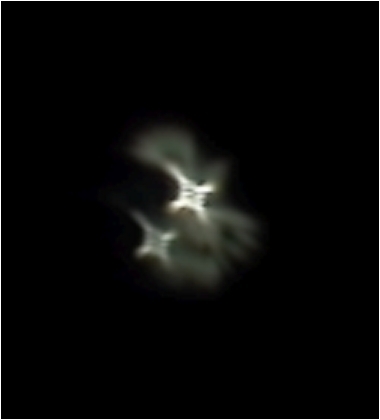
MIZAR-Ζ URSÆ MAJORIS SYSTEM
2009.V.19.2251 UT
* * *
Observation #74, 2008.XII.18-19 - Crab Nebula supernova remnant, Messier #1 - Gemini open star cluster, Messier #35 - 'Beehive' open star cluster, Messier #44
2341 UT
Had not planned on observing, having expected continued cloud and fog, but immediately upon seeing how clear the sky was immediately set up the telescope in the yard. Collimated at ×600 magnification first on Mintaka in Orion, then on Bellatrix when Mintaka began to move close to a building. Seeing made it difficult to centralize the star exactly in the diffraction pattern of concentric rings ('Fresnel' rings) when just out of focus, but given the conditions I could not have needed to collimate any more precisely than I was able to. Still am not sure about the Airy diffraction pattern at focus; but was satisfied to see the beautiful blue diamond of Bellatrix at focus at ×600, with spikes coming off at all points of the compass and a perfect circle of light around her.
2357
Had planned to use the new Ultra High Contrast filter on the Orion Nebula, but the nebula was now too low behind the garden wall. Decided to have a good peer at the Crab Nebula supernova remnant Messier #1 through the filter instead. Some confusion at first, found ζ Tauri directly using the finderscope, but had trouble remembering the nearby 'golf flag' constellation (as I call it) which I use to find M1, as the nebula and its surroundings were tilted at an unfamiliar angle. After refreshing my memory using the computer planetarium, noted that M1 itself forms a triangle with HIP26159 (the bottom of the flagpole) and HIP26328. With this information I was able to find the nebula easily, and certainly will do so again every time hereafter. With the filter in at ×40 magnification the nebula was obvious, and although faint I might not have missed it even if I didn't know it was there and was not looking for it. Feeling confident I increased the magnification to ×80 and settled at the eyepiece for a good long peer at the thing, the remnant of a massive star that exploded with stupefying catastrophic violence around seven thousand years ago. Being 6,000 light years away (35,000 billion miles) the supernova was not observed and documented until Chinese astronomers noted the bright explosion in 1054 AD, which has since then subsided leaving a glowing gas cloud with a pulsar at the centre. My prior observations of M1 showed little more than a barely visible dim patch which wasn't really worth looking into any more than that. However, with the UHC filter in, the nebula was plain if faint, and after increasing the magnification to ×80, with careful study I was able to note and record variations in brightness and shape, although these were not clearly delineated. Comparing my rough sketches with a professional long exposure image of the nebula, I saw that the details I had recorded corresponded very well with those in the photograph.
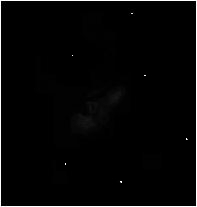
CRAB NEBULA SUPERNOVA REMNANT, MESSIER #1
2008.XII.18-19.2357-0026 UT
0026
With M1 moving out of view and Gemini perfectly placed, I checked for more Messier objects in the vicinity on the computer planetarium. The open star cluster M35 was the most obvious target, at 2,800 light years (16,500 billion miles) distant, and I plotted my strategy from my charts. The star in the top right corner of the long quadrilateral of Gemini, Tejat Posterior, and its neighbour, Tejat Prior, was my first target with the finderscope. Centring Tejat Prior in the main scope, I tracked northeast to the triangle WY Geminorum, 6U Geminorum, and HIP29288, with 3 Geminorum next to HIP29288. From 3 Geminorum I tracked northeast then north along a chain of faint stars TYC1877-1004-1, TYC1864-318-1, HIP29081, and TYC1864-362-1. Almost got lost making the final hop from TYC1864-362-1 to M35, but happened upon the outskirts of the cluster just as I was about to start again from Tejat Prior, and brought the cluster into the centre of the field of view. First impressions were so overwhelming that after a brief stare in surprise and awe (normally I find star clusters relatively dull objects) I had to rush indoors to jot my impressions down in note form for fear of forgetting them, as if that were the most important thing in the world for me to do. The first word of my notes, which I made a point of emphasizing, was stillness, the stillness of the thing. The nucleus of the cluster looked as if it should have been an obvious frenzy of activity and movement: a hundred or more bright young white stars all more or less in the same place, frozen still like a film on freeze frame. Brighter stars crowded out the rest of the view, thinning out to the edge of the field. Although I understand that it is a human trait to see identifiable forms in random shapes, the stars of the nucleus appeared to form organic patterns, and I couldn't help but feel a very real and very ordinary sense of simple deliberate design in the structure. It was very like looking down on the lights of a village from a distance at night, with street lighting and lights on in the houses; the lights, though not in a regular pattern, are obviously put there deliberately by someone, and appear homely but not necessarily welcoming to complete strangers who turn up unannounced in the middle of the night. Most notable was the constellation of stars surrounding the nucleus in a skewed pentagon shape; it looked very much like a Newcastle Coal (a black boiled sweet covered with sugar) with the stars appearing like glinting facets of the sugar crystals coating the sweet. This cluster does not have a nickname yet. Certainly I shall consider calling M35 the 'Newcastle Coal' cluster myself from now on even if nobody else ever does; my great-grandfather was a coal miner, although he was from Leicestershire. Besides which, the 'Blackberry Fruit Pastille' cluster doesn't really scan. However, I shall wait until I have observed a fair number of other such clusters before presuming to name this one, as it is perfectly likely that they all look like Newcastle Coals.
0101
After jotting some more notes, had another quick look at the cluster before it moved out of view. I don't think that I have yet seen anything more beautiful. I've seen the Earthshine, I've seen the first morning rays of the Sun catching mountaintops on the Moon at Lunar dawn, I've seen subtle cloud patterns in the atmosphere of Venus, I've seen the rings of Saturn, the Andromeda Spiral Galaxy, the Orion Nebula, a handful of other star clusters, but this takes the biscuit. I have consciously neglected to observe clusters because I didn't see the point in observing them; certainly I couldn't make the effort to sketch them, and certainly they seemed like far less exciting targets than the galaxies and nebulæ which have always fascinated me, and which never fail to hold my attention no matter how few of their secrets they yield up. But this M35 is the single most beautiful thing I've seen in the heavens so far. Every time I have the opportunity, the equipment, and the art to take a good close look at a new deep sky object, it is exactly like opening a poor old long-forgotten box, to find it full of rare pearls or gemstones, only more fulfilling.
0130
Decided to look for an old target from boyhood, the Præsepe or Beehive Cluster, M44, fairly high in the southeast over central Coventry, 500 light years away (3,000 billion miles). I don't remember ever seeing this cluster as anything more than a fuzzy patch in the middle of the central triangle in the constellation of Cancer, by naked eye. Tonight however, light pollution from Coventry badly fogged the view by eye and the cluster was invisible without optical aid. In fact seeing the central triangle of η Cancri, Asellus Borealis and Asellus Australis was awkward through the yellow fog. Once I had spotted them by eye though, knowing the position already I was able to point the finderscope directly at the cluster and land directly on it through the main scope at ×40. The scope's magnification cut clear through the yellow fog from Coventry's sodium street lamps, and the cluster was plain to see, although after M35 the Beehive seemed dull by comparison. I dare say that I was only seeing the brightest sixth magnitude stars of the cluster.
* * *
Observation #73, 2008.XII.15 - Great Spiral Galaxy of Andromeda, Messier #31

ANDROMEDA SPIRAL GALAXY, MESSIER #31
2008.XII.15.2116 UT
This is the most obvious galactic target in the northern hemisphere, being visible with the naked eye. It is roughly half as large again as our own Milky Way Galaxy, and as such is the largest member of the 'Local Group' cluster of galaxies of which our Galaxy is also a member (the second largest after Andromeda in fact). At a distance of 2.2 million light years (roughly 13 trillion miles in British English, 13 quintillion miles in American English, 13,000,000,000,000,000,000 miles in Arabic numerals) the Andromeda galaxy is the most distant object visible to the naked eye.
* * *
Observation #34, 2007.XII.14 - Great Nebula of Orion, Messier #42

ORION NEBULA, MESSIER #42
2007.XII.14.0021 UT
* * *
Observation #26, 2007.XII.02 - Pisces open spiral galaxy, Messier #74

PISCES OPEN SPIRAL GALAXY, MESSIER #74
2007.XII.2.0002 UT
Despite my excellent navigation charts I have not been able to find this galaxy since, and wonder if I was not merely looking at an out of focus star when I observed it. Nevertheless I was convinced that I was looking at a galaxy at the time, and the stars in my sketch actually exist in front of the galaxy, which I didn't realize when I made the drawing. This is the most remote object that I have yet observed, at around 26 million light years distant, that's over 150 trillion (150,000,000,000,000,000,000) miles. I had a headache for two days after making this observation, and I had not been drinking either.
* * *
Observation #15, 2007.III.6 - Monoceros open star cluster, Messier #50

MONOCEROS OPEN STAR CLUSTER, MESSIER #50
2007.III.6.2131 UT
This star cluster may be seen with binoculars, but needs a telescope to really separate the individual stars. It is 3,000 light-years away.
* * *
Observation #14b, 2007.III.3 - Great Nebula of Orion, Messier #42

ORION NEBULA, MESSIER #42
2007.III.3.2028 UT
My first detailed sketch of the Orion Nebula.
You may return to the index page, when you are quite sure that you've seen enough here.